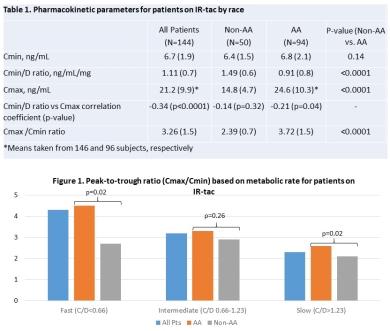Assessment of Peak Levels and Metabolism Rates in African American (AA) and Non-AA Kidney Transplant Recipients (KTR) on Immediate-Release Tacrolimus (IR-tac)
1Barnes-Jewish Hospital, St. Louis, MO
2St. Louis University, St. Louis, MO
3Columbia University, New York, NY
4Veloxis Pharmaceuticals, Cary, NC
5University of Alabama, Birmingham, AL.
Meeting: 2018 American Transplant Congress
Abstract number: C82
Keywords: FK506, Immunosuppression, Pharmacokinetics
Session Information
Session Name: Poster Session C: Kidney Immunosuppression: Novel Regimens and Drug Minimization
Session Type: Poster Session
Date: Monday, June 4, 2018
Session Time: 6:00pm-7:00pm
 Presentation Time: 6:00pm-7:00pm
Presentation Time: 6:00pm-7:00pm
Location: Hall 4EF
Trough-to-daily dose (C/D) ratio has been used as a simple method for evaluation of IR-tac metabolism rate. Recent studies have shown that fast metabolizers defined by low C/D ratio are at greater risk of tac related toxicities, possibly due to elevated peak concentrations (Cmax). Objectives of this study are to 1) determine the correlation between C/D ratio and Cmax and 2) compare metabolic rate and Cmax between AA and Non-AA KTR on IR-tac.
Steady state data from three separate PK studies comparing IR-tac to extended-release tac (Envarsus XR) were analyzed. Correlation coefficient was calculated between C/D ratio and Cmax concentration for IR-tac patients. Peak-to-trough (Cmax/Cmin) ratios were also assessed according to metabolic rate tertiles and race.
A total of 123 stable KTR (mean 3.6 y post-transplant) with 144 PK evaluations were analyzed. 63% of patients were male, and 59% were AA. The mean C/D ratio and Cmax for all patients were 1.11 and 21.2 ng/mL, respectively.  A weak but significant inverse relationship was seen between C/D ratio and Cmax in all patients. This relationship was weaker in AAs alone and not significant in Non-AAs. AA exhibited significantly lower C/D and higher Cmax compared to Non-AAs despite comparable Cmin. Accordingly, Cmax/Cmin ratio was significantly higher for AAs. When grouped by C/D tertiles, a gradual decline in Cmax/Cmin ratio was seen among fast, intermediate, and slow metabolizers, respectively, with consistently higher ratios among AAs.
A weak but significant inverse relationship was seen between C/D ratio and Cmax in all patients. This relationship was weaker in AAs alone and not significant in Non-AAs. AA exhibited significantly lower C/D and higher Cmax compared to Non-AAs despite comparable Cmin. Accordingly, Cmax/Cmin ratio was significantly higher for AAs. When grouped by C/D tertiles, a gradual decline in Cmax/Cmin ratio was seen among fast, intermediate, and slow metabolizers, respectively, with consistently higher ratios among AAs.
A weak but significant inverse correlation exists between C/D and Cmax for patients on IR-tac. This suggests overall exposure of tac varies significantly in rapid metabolizers, and the impact on adverse events should be further explored. Furthermore, data presented here may provide clinicians with insight into peak tac exposure using readily available data such as race, trough level, and daily dose.
CITATION INFORMATION: Horwedel T., Sodhi R., Tsapapas D., Mills M., Patel S., Towns G. Assessment of Peak Levels and Metabolism Rates in African American (AA) and Non-AA Kidney Transplant Recipients (KTR) on Immediate-Release Tacrolimus (IR-tac) Am J Transplant. 2017;17 (suppl 3).
To cite this abstract in AMA style:
Horwedel T, Sodhi R, Tsapapas D, Mills M, Patel S, Towns G. Assessment of Peak Levels and Metabolism Rates in African American (AA) and Non-AA Kidney Transplant Recipients (KTR) on Immediate-Release Tacrolimus (IR-tac) [abstract]. https://atcmeetingabstracts.com/abstract/assessment-of-peak-levels-and-metabolism-rates-in-african-american-aa-and-non-aa-kidney-transplant-recipients-ktr-on-immediate-release-tacrolimus-ir-tac/. Accessed December 19, 2025.« Back to 2018 American Transplant Congress
